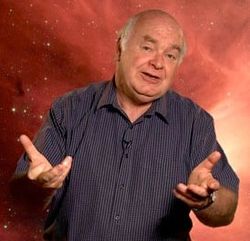Bloggfærslur mánaðarins, september 2010
6.9.2010 | 14:03
John Lennox um rök Stephen Hawkings
 John Lennox er prófessor í stærðfræði við Oxford hefur skrifað góða grein þar sem hann útskýrir af hverju Stephen Hawkins hefur rangt fyrir sér þegar hann segir að það er hægt að útskýra alheiminn án Guðs.
John Lennox er prófessor í stærðfræði við Oxford hefur skrifað góða grein þar sem hann útskýrir af hverju Stephen Hawkins hefur rangt fyrir sér þegar hann segir að það er hægt að útskýra alheiminn án Guðs.
As a scientist I’m certain Stephen Hawking is wrong. You can’t explain the universe without God.
There’s no denying that Stephen Hawking is intellectually bold as well as physically heroic. And in his latest book, the renowned physicist mounts an audacious challenge to the traditional religious belief in the divine creation of the universe.
According to Hawking, the laws of physics, not the will of God, provide the real explanation as to how life on Earth came into being. The Big Bang, he argues, was the inevitable consequence of these laws ‘because there is a law such as gravity, the universe can and will create itself from nothing.’
 Unfortunately, while Hawking’s argument is being hailed as controversial and ground-breaking, it is hardly new.
Unfortunately, while Hawking’s argument is being hailed as controversial and ground-breaking, it is hardly new.
For years, other scientists have made similar claims, maintaining that the awesome, sophisticated creativity of the world around us can be interpreted solely by reference to physical laws such as gravity.
It is a simplistic approach, yet in our secular age it is one that seems to have resonance with a sceptical public.
But, as both a scientist and a Christian, I would say that Hawking’s claim is misguided. He asks us to choose between God and the laws of physics, as if they were necessarily in mutual conflict.
But contrary to what Hawking claims, physical laws can never provide a complete explanation of the universe. Laws themselves do not create anything, they are merely a description of what happens under certain conditions.
What Hawking appears to have done is to confuse law with agency. His call on us to choose between God and physics is a bit like someone demanding that we choose between aeronautical engineer Sir Frank Whittle and the laws of physics to explain the jet engine.
That is a confusion of category. The laws of physics can explain how the jet engine works, but someone had to build the thing, put in the fuel and start it up. The jet could not have been created without the laws of physics on their own - but the task of development and creation needed the genius of Whittle as its agent.
Similarly, the laws of physics could never have actually built the universe. Some agency must have been involved.
To use a simple analogy, Isaac Newton’s laws of motion in themselves never sent a snooker ball racing across the green baize. That can only be done by people using a snooker cue and the actions of their own arms.
Hawking’s argument appears to me even more illogical when he says the existence of gravity means the creation of the universe was inevitable. But how did gravity exist in the first place? Who put it there? And what was the creative force behind its birth?
Similarly, when Hawking argues, in support of his theory of spontaneous creation, that it was only necessary for ‘the blue touch paper’ to be lit to ‘set the universe going’, the question must be: where did this blue touch paper come from? And who lit it, if not God?
Much of the rationale behind Hawking’s argument lies in the idea that there is a deep-seated conflict between science and religion. But this is not a discord I recognise.
For me, as a Christian believer, the beauty of the scientific laws only reinforces my faith in an intelligent, divine creative force at work. The more I understand science, the more I believe in God because of my wonder at the breadth, sophistication and integrity of his creation.
The very reason science flourished so vigorously in the 16th and 17th centuries was precisely because of the belief that the laws of nature which were then being discovered and defined reflected the influence of a divine law-giver.
One of the fundamental themes of Christianity is that the universe was built according to a rational , intelligent design. Far from being at odds with science, the Christian faith actually makes perfect scientific sense.
Some years ago, the scientist Joseph Needham made an epic study of technological development in China. He wanted to find out why China, for all its early gifts of innovation, had fallen so far behind Europe in the advancement of science.
He reluctantly came to the conclusion that European science had been spurred on by the widespread belief in a rational creative force, known as God, which made all scientific laws comprehensible.
Despite this, Hawking, like so many other critics of religion, wants us to believe we are nothing but a random collection of molecules, the end product of a mindless process.
This, if true, would undermine the very rationality we need to study science. If the brain were really the result of an unguided process, then there is no reason to believe in its capacity to tell us the truth.
We live in an information age. When we see a few letters of the alphabet spelling our name in the sand, our immediate response is to recognise the work of an intelligent agent. How much more likely, then, is an intelligent creator behind the human DNA, the colossal biological database that contains no fewer than 3.5 billion ‘letters’?
It is fascinating that Hawking, in attacking religion, feels compelled to put so much emphasis on the Big Bang theory. Because, even if the non-believers don’t like it, the Big Bang fits in exactly with the Christian narrative of creation.
That is why, before the Big Bang gained currency, so many scientists were keen to dismiss it, since it seemed to support the Bible story. Some clung to Aristotle’s view of the ‘eternal universe’ without beginning or end; but this theory, and later variants of it, are now deeply discredited.
But support for the existence of God moves far beyond the realm of science. Within the Christian faith, there is also the powerful evidence that God revealed himself to mankind through Jesus Christ two millennia ago. This is well-documented not just in the scriptures and other testimony but also in a wealth of archaeological findings.
Moreover, the religious experiences of millions of believers cannot lightly be dismissed. I myself and my own family can testify to the uplifting influence faith has had on our lives, something which defies the idea we are nothing more than a random collection of molecules.
Just as strong is the obvious reality that we are moral beings, capable of understanding the difference between right and wrong. There is no scientific route to such ethics.
Physics cannot inspire our concern for others, or the spirit of altruism that has existed in human societies since the dawn of time.
The existence of a common pool of moral values points to the existence of transcendent force beyond mere scientific laws. Indeed, the message of atheism has always been a curiously depressing one, portraying us as selfish creatures bent on nothing more than survival and self-gratification.
Hawking also thinks that the potential existence of other lifeforms in the universe undermines the traditional religious conviction that we are living on a unique, God-created planet. But there is no proof that other lifeforms are out there, and Hawking certainly does not present any.
It always amuses me that atheists often argue for the existence of extra-terrestrial intelligence beyond earth. Yet they are only too eager to denounce the possibility that we already have a vast, intelligent being out there: God.
Hawking’s new fusillade cannot shake the foundations of a faith that is based on evidence
Fengið héðan: John Lennox: Stephen Hawking is wrong. You can’t explain the universe without God
Vísindi og fræði | Breytt s.d. kl. 15:44 | Slóð | Facebook | Athugasemdir (47)
2.9.2010 | 16:05
Hvað orsakaði þyngdarlögmálið?
Lögmál náttúrunnar eru ekkert sjálf gefin, það er ekki eins og þau þurfa að vera til eða vera eins og þau eru núna. Þannig að stóra spurningin til Hawkins er "hver bjó til þyngdarlögmálið?"
Það er síðan ekki bara það heldur líka hvaðan kom orkan? Og af hverju er nýtilega orkan í okkar alheimi alltaf að minnka?
Stjarnfræðingurinn Robert Jastrow orðaði þetta svona:
Robert Jastrow
The Second Law of Thermodynamics, applied to the cosmos, indicates the universe is running down like a clock. If it is running down, there must have been a time when it was fully wound up…if our views are right, somewhere between the beginning of time and the present day we must place the winding up of the universe
Það er einmitt málið, það verður einhver sem hefur vald á þessum náttúrulögmálum að beygja þau í upphafi til þess að alheimurinn gæti verið til.
Síðan varðandi fullyrðingu Hawkins að ekkert bendir til þess að það er einhver hönnuður á bakvið jörðina okkar þá langar mig að benda á mynd þar sem nokkrir vísindamenn fjalla um gögn sem þeir telja að benda til þess að jörðin okkar var hönnuð, sjá: Privileged planet
Því miður þá ganga sumir menn með þær ranghugmyndir í kollinum að hin vísindalega aðferð snýst um að útskýra allt án Guðs en ekki að rannsaka heiminn sem við lifum í til að öðlast meiri þekkingu á honum. Ef sú þekking styður tilvist Guðs þá hefur alvöru vísindamaður ekki neitt á móti því vegna þess að hann er að leita að sannleikanum.
Robert Jastrow fjallaði líka um þetta:
Robert Jastrow
Theologians generally are delighted with the proof that the universe had a beginning, but astronomers are curiously upset. It turns out that the scientist behaves the way the rest of us do when our beliefs are in conflict with the evidence
Málið er að við erum með vísindamenn sem trúa á Guð og við erum með vísindamenn sem trúa ekki á Guð. Þeir eru síðan bara mannlegir og berjast oft fyrir sinni uppáhalds kenningu vegna stolts og heiðurs. Hver vill að allir viti að doktors námið hans var tímasóun?
Nei, það er gífurlega margt sem styður tilvist Guðs og ef þetta eru bestu rök Hawkins fyrir því að Guð er ekki til þá er hans trú veiklulegri en ég hélt.

|
Ljóst að Guð skapaði ekki heiminn |
| Tilkynna um óviðeigandi tengingu við frétt | |
Vísindi og fræði | Breytt s.d. kl. 16:55 | Slóð | Facebook | Athugasemdir (39)
2.9.2010 | 11:21
Darwinisti ræðst á Discovery Channel
 Maður að nafni James Lee réðst á Discovery Channel með kröfur sem má lesa hérna: http://tmz.vo.llnwd.net/o28/newsdesk/tmz_documents/0901_demands.pdf
Maður að nafni James Lee réðst á Discovery Channel með kröfur sem má lesa hérna: http://tmz.vo.llnwd.net/o28/newsdesk/tmz_documents/0901_demands.pdf
Hérna eru nokkur dæmi úr kröfulistanum:
Focus must be given on how people can live WITHOUT giving birth to more filthy
human children since those new additions continue pollution and are pollution. A game show format contest would be in order. Perhaps also forums of leading scientists who understand and agree with the
Malthus-Darwin science and the problem of human overpopulation.
...
All programs on Discovery Health-TLC must stop encouraging the birth of any more parasitic human infants and the false heroics behind those actions. In those programs' places, programs encouraging
human sterilization and infertility must be pushed.
...
Develop shows that mention the Malthusian sciences about how food production leads to the overpopulation of the Human race. Talk about Evolution. Talk about Malthus and Darwin until it sinks into the stupid people's brains until they get it!!
...
That means stopping the human race from breeding any more disgusting human babies!
Út frá sjónarhóli þróunarkenningarinnar þar sem menn eru aðeins dýr og hafa ekkert meira vægi en önnur dýr þá er Lee að hugsa hérna rökrétt en vægast sagt ekki á mjög kærleiksríkan hátt. Að koma í veg fyrir að sumt fólk geti ekki eignast börn kom beint frá frænda Darwins, Francis Galton. Sú stefna var kölluð Eugenics og rökrétt áframhald af kenningum Darwins.
Rökhugsun og kærleikur, eiga oft litla samleið. Sá sem heldur að skynsemin geti sigrast á græðgi og illsku þarf að lesa meira í mannkynssögunni.
Kemur heldur ekki á óvart að James Lee var líka á móti trúarbrögðum "Civilization must be exposed for the filth it is. That, and all its disgusting religious-cultural roots and
greed.".

|
Maðurinn var skotinn |
| Tilkynna um óviðeigandi tengingu við frétt | |
1.9.2010 | 11:54
Rannsóknir á hönnun í náttúrunni
 Það er mikið um að vera í rannsóknum á náttúrunni og tilraunum vísindamanna að herma eftir þeirri hönnun sem þar er að finna. Fyrir mig þá eru þetta dæmi um rannsóknir í anda Vitrænnar hönnunar, þ.e.a.s. rannsaka náttúruna og komast að því hvernig við sem vitrænir hönnuðir getum hermt eftir þessum hlutum og lært sitthvað um hönnun.
Það er mikið um að vera í rannsóknum á náttúrunni og tilraunum vísindamanna að herma eftir þeirri hönnun sem þar er að finna. Fyrir mig þá eru þetta dæmi um rannsóknir í anda Vitrænnar hönnunar, þ.e.a.s. rannsaka náttúruna og komast að því hvernig við sem vitrænir hönnuðir getum hermt eftir þessum hlutum og lært sitthvað um hönnun.
- Embryo trick: Scientists inspired by the cilia that embryos use to direct cells to their places copied the trick with “biomimetic cilia” they hope to use with lab-on-a-chip applications (see abstract at PNAS).
- Stickybot: Inspired by gecko feet, scientists at Stanford designed a look-alike robot, reported Science Daily, that uses the same principle of dry adhesion by multiplication of surface contacts. “The material is strong and reusable, and leaves behind no residue or damage,” just like a gecko foot, the article said. They even imitated the gecko’s rotating ankles so that it can change direction.
- Perfect little engine: Ever heard of a salp? This small jelly-like creature lives in the sea and is important for carbon cycle. Science Daily told about its “near-perfect little engine” that propels it and filters its food with a microscopic mesh. Because “the scientists are captivated by the unique, almost magical performance of this natural undersea engine,” they think inventors could learn something. Science Daily asked, “What if trains, planes, and automobiles all were powered simply by the air through which they move? Moreover, what if their exhaust and byproducts helped the environment? Well, such an energy-efficient, self-propelling mechanism already exists in nature.”
- Beetle bifocals: Scientists at the University of Cincinnati were stunned to find a diving beetle with bifocal compound eyes. Live Science reported that the eyes have two retinas, one for distance and one for close-up inspection. Analysis of how this unique beetle sees could help bifocal manufacture. “Bifocal glasses and contacts create two images that interfere with each other, creating an area of blur,” the article said. “The beetle larvae solve this interference problem by having focal planes are slightly shifted so they aren’t completely on top of each other. In fact, the researchers found the shift of the focal planes improved contrast of the resulting image three-fold.”
- Oyster glue: The Navy is employing “interdisciplinary, cutting-edge research” to copy oysters. The amazing underwater adhesives that oysters use are attractive to the Navy not only because of their importance to the marine ecology, but also because of the insights they provide. Naval researchers have been “studying marine animals’ various adhesives, uncovering fundamental properties that could yield new innovations from replacements for medical sutures to surface coatings that keep waterborne craft from picking up marine hitchhikers,” the article said. They found that oysters have a unique adhesive for sticking to one another as they build oyster reefs.
- Put on your bacteria: New Scientist posted an unusual article and video about researchers using bacteria to grow fibers for clothing. Such biodegradable clothing will be “green” not necessarily in color, but in the sense of being biodegradable and environmentally-friendly.
- Code in the nose: Inventors have been working on artificial noses for some time, with only mixed results at distinguishing the thousands of odors that natural noses are so good at detecting. PhysOrg reported that Stanford inventors are finding that a touch of DNA helps. The combinatorial flexibility of DNA is providing the coding repertoire for sensors to respond to many more molecules than before. Live Science added that frog egg cells are providing a key ingredient in robotic noses as receptors.
- Cornea breakthrough: Synthetic corneas are too hard to make, and cornea transplants are expensive and difficult, so why not regrow the real thing? The BBC News reported that biosynthetic implants, using “a synthetic version of human collagen designed to mimic the cornea as closely as possible,” are providing real hope for restoring impaired vision. Already in tests patients reported “dramatically improved” vision with the new technique.
- Pop goes the circuit: Manufacturing circuits inspired by bacteria? Why not? Synthetic circuits is a relatively new method within the “emerging field of synthetic biology” of organizing genetically-modified bacteria to “produce a myriad of useful proteins, enzymes or chemicals in a coordinated way.” Science Daily reported that scientists at Duke University were surprised to find bacterial cells popping, or committing suicide, when reaching a certain stage of plasmid density. They modeled the behavior with a sample circuit they called ePop and found that it can “increase the efficiency and power of future synthetic biology circuits.”
- Flying with altitude: Somehow, fruit flies know the right altitude for their flying and hovering needs. Live Science reported that findings about how they calculate optic flow might help designers of “insect-inspired robots.” Mike Dickinson’s team at Caltech found that flies use horizontal edges and “integrate edge information with other visual information to pick flight plans.” This work not only helps “unveil the mysteries of insect flight and cognition, but it may have practical implications for humans, as well.”
Þessi samantekt af fréttum var tekin héðan: http://www.creationsafaris.com/crev201008.htm
Eins og vanalega þá er ekkert gagn af þróunartrúnni í þessum vísindum. Örfáir eru til í að eyða tíma í að gíska á það hvernig tilviljanir og náttúruval fór að því að búa til þessi hönnunar undur. Það er vonandi ekki langt í að þessi þróunar trú deyi út og alvöru vísindi fái að blómstra án þessara truflana.
Vísindi og fræði | Breytt s.d. kl. 12:56 | Slóð | Facebook | Athugasemdir (2)
Um bloggið
Mofa blogg
Færsluflokkar
- Bloggar
- Bækur
- Dægurmál
- Ferðalög
- Fjármál
- Fjölmiðlar
- Heilbrigðismál
- Heimspeki
- Íþróttir
- Kjaramál
- Kvikmyndir
- Lífstíll
- Ljóð
- Löggæsla
- Mannréttindi
- Matur og drykkur
- Menning og listir
- Menntun og skóli
- Samgöngur
- Sjónvarp
- Spaugilegt
- Spil og leikir
- Stjórnmál og samfélag
- Sveitarstjórnarkosningar
- Tónlist
- Trúmál
- Trúmál og siðferði
- Tölvur og tækni
- Umhverfismál
- Utanríkismál/alþjóðamál
- Vefurinn
- Viðskipti og fjármál
- Vinir og fjölskylda
- Vísindi og fræði
Tenglar
Kristnar síður
Ýmislegt
Sköpun/þróun
Síður sem fjalla um sköpun/þróun
- Detecting Design
- UnCommon descent Blogg síða William Dembski um vitræna hönnun
- Creation-Evolution Headlines Síða sem fjallar um fréttir tengdar sköpun þróun
- EvolutionNews Síða sem fjallar um fréttir sem tengjast Vitsmunahönnun
Bloggvinir
- Bergur Thorberg
- Birgirsm
- Brosveitan - Pétur Reynisson
- Bryndís Böðvarsdóttir
- Daníel Þór Þorgrímsson
- Davíð S. Sigurðsson
- Davíð Örn Sveinbjörnsson
- Daði Einarsson
- Dóra litla
- Eva
- Eygló Hjaltalín
- Friðrik Páll Friðriksson
- Georg P Sveinbjörnsson
- Gladius
- Gunnar Ingi Gunnarsson
- Gunnlaugur Halldór Halldórsson
- Guðni Már Henningsson
- Guðrún Sæmundsdóttir
- Guðsteinn Haukur Barkarson
- Gísli Kristjánsson
- Halldóra Hjaltadóttir
- Halldóra Lára Ásgeirsdóttir
- Hjalti Rúnar Ómarsson
- Hörður Finnbogason
- Hörður Halldórsson
- Inga Helgadóttir
- Ingibjörg
- Ingvar Leví Gunnarsson
- Ingvar Valgeirsson
- Janus Hafsteinn Engilbertsson
- Jens Sigurjónsson
- Jóhann Hauksson
- Jóhann Helgason
- Jóhannes Ólafsson Eyfeld
- Jón Hjörleifur Stefánsson
- Jón Ríkharðsson
- Jón Valur Jensson
- Jónatan Gíslason
- Júdas
- Kristin stjórnmálasamtök
- Kristinn Theódórsson
- Kristinn Theódórsson
- Kristinn Ásgrímsson
- Linda
- Mama G
- Morgunstjarnan
- Nonni
- Omnivore
- Predikarinn - Cacoethes scribendi
- Pétur Eyþórsson
- Ragnar Birkir Bjarkarson
- Ragnar Kristján Gestsson
- Ragnar Steinn Ólafsson
- Ragnheiður Katla Laufdal
- Róbert Badí Baldursson
- Rósa Aðalsteinsdóttir
- Rödd í óbyggð, kristilegt félag
- Röddin
- Rúnar Kristjánsson
- Sigurður Þórðarson
- Sigvarður Hans Ísleifsson
- Steinar Immanúel Sörensson
- Styrmir Reynisson
- Svanur Gísli Þorkelsson
- Sverrir Halldórsson
- TARA
- TARA ÓLA/GUÐMUNDSD.
- Theódór Norðkvist
- Tryggvi Hjaltason
- Tímanna Tákn
- Unknown
- Vefritid
- Viðar Freyr Guðmundsson
- gudni.is
- Ólafur Jóhannsson
- Þarfagreinir
- Þórdís Ragnheiður Malmquist
- Alexander Steinarsson Söebech
- Árni Karl Ellertsson
- BookIceland
- Elísa Elíasdóttir
- Fanney Amelía Guðjonsson
- Friðrik Már
- Gestur Halldórsson
- Guðjón E. Hreinberg
- Gunnar Ingvi Hrólfsson
- Gunnar Jóhannesson
- Hulda Þórey Garðarsdóttir
- Jens Guð
- Karl Jóhann Guðnason
- Kristinn Ingi Jónsson
- Lífsréttur
- Mathieu Grettir Skúlason
- Tómas Ibsen Halldórsson
- Valur Arnarson
- Viktor
- Vilhjálmur Örn Vilhjálmsson
Heimsóknir
Flettingar
- Í dag (18.9.): 0
- Sl. sólarhring: 1
- Sl. viku: 7
- Frá upphafi: 0
Annað
- Innlit í dag: 0
- Innlit sl. viku: 7
- Gestir í dag: 0
- IP-tölur í dag: 0
Uppfært á 3 mín. fresti.
Skýringar







